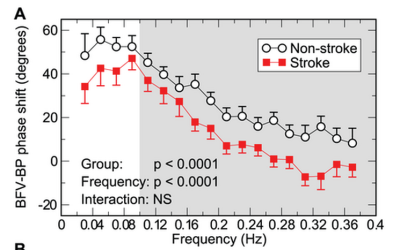So have they thought that maybe pericytes haven't opened up yet?
http://oc1dean.blogspot.com/2011/09/restoring-capillary-blood-flow-after.html
You can easily verify if this hypothesis is correct or not by checking if these problems occur by ischemic vs. hemorrhagic stroke.
http://brainslab.wordpress.com/2012/07/13/38975849/
In everyday life, your muscles, metabolism, and nervous system work
together to ensure that your cerebral blood flow meets the metabolic
needs of your various brain regions. So if you are trying to scrutinize
an impressionist painting, your body will likely relocate more blood flow to your visual cortex.
Following a stroke, this cerebral blood flow regulation is impaired.
But, the degree and spread of the impairment is unknown. To investigate
this, Hu et al. measured systemic blood pressure (BP) and used a transcranial doppler to measure cerebral blood flow velocity (BFV) at the same time.
In their model, better regulation of cerebral blood flow corresponds
to a sharper phase shift between blood pressure (BP) and cerebral blood
flow velocity (BFV). Individuals with the highest score of a 9 on their
autoregulation index (ARI) have more regulation than those with the
lowest score of 0, which corresponds to no phase shift.
When they compared patients who had experienced MCA infarcts (a
common type of stroke) and healthy controls, they found that stroke
patients had significantly less phase coupling between blood pressure
and cerebral blood flow. This effect was pronounced over a wide range of
blood pressure oscillation frequencies.
Given enough time and the right conditions, can the body repair its
ability to regulate cerebral blood flow following a stroke? When the
researchers examined this, they found no statistically significant
difference between the BFV-BP phase difference and time since stroke.
But, that doesn’t mean that there’s a statistically significant lack
of difference. So, further longitudinal studies will be needed to help
clarify whether, in certain people in certain environments, the brain
improves its cerebral regulation following stroke.
Reference
Hu K, Lo M-T, Peng C-K, Liu Y, Novak V (2012) A Nonlinear Dynamic
Approach Reveals a Long-Term Stroke Effect on Cerebral Blood Flow
Regulation at Multiple Time Scales. PLoS Comput Biol 8(7): e1002601.
doi:10.1371/journal.pcbi.1002601
Use the labels in the right column to find what you want. Or you can go thru them one by one, there are only 31,940 posts. Searching is done in the search box in upper left corner. I blog on anything to do with stroke. DO NOT DO ANYTHING SUGGESTED HERE AS I AM NOT MEDICALLY TRAINED, YOUR DOCTOR IS, LISTEN TO THEM. BUT I BET THEY DON'T KNOW HOW TO GET YOU 100% RECOVERED. I DON'T EITHER BUT HAVE PLENTY OF QUESTIONS FOR YOUR DOCTOR TO ANSWER.
Changing stroke rehab and research worldwide now.Time is Brain! trillions and trillions of neurons that DIE each day because there are NO effective hyperacute therapies besides tPA(only 12% effective). I have 523 posts on hyperacute therapy, enough for researchers to spend decades proving them out. These are my personal ideas and blog on stroke rehabilitation and stroke research. Do not attempt any of these without checking with your medical provider. Unless you join me in agitating, when you need these therapies they won't be there.
What this blog is for:
My blog is not to help survivors recover, it is to have the 10 million yearly stroke survivors light fires underneath their doctors, stroke hospitals and stroke researchers to get stroke solved. 100% recovery. The stroke medical world is completely failing at that goal, they don't even have it as a goal. Shortly after getting out of the hospital and getting NO information on the process or protocols of stroke rehabilitation and recovery I started searching on the internet and found that no other survivor received useful information. This is an attempt to cover all stroke rehabilitation information that should be readily available to survivors so they can talk with informed knowledge to their medical staff. It lays out what needs to be done to get stroke survivors closer to 100% recovery. It's quite disgusting that this information is not available from every stroke association and doctors group.
Friday, July 13, 2012
Cerebral blood flow regulation systematically decreases after a stroke
Labels:
blood flow,
pericytes
Subscribe to:
Post Comments (Atom)


No comments:
Post a Comment